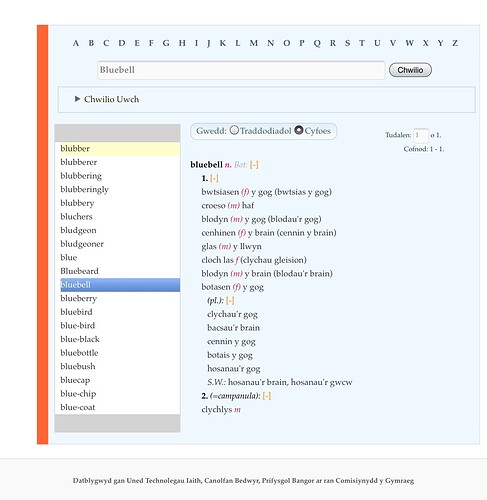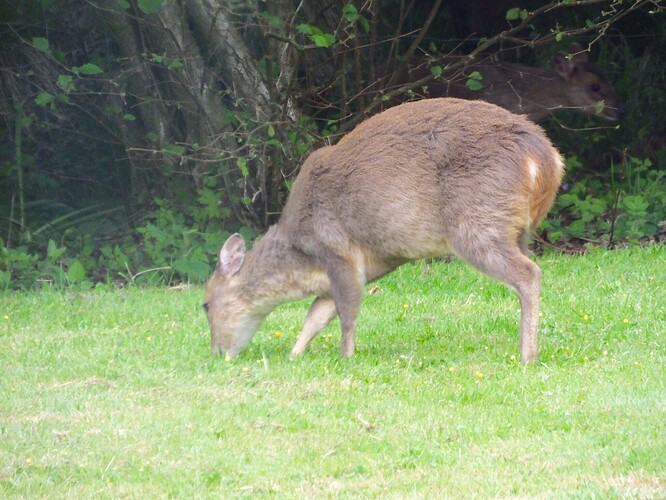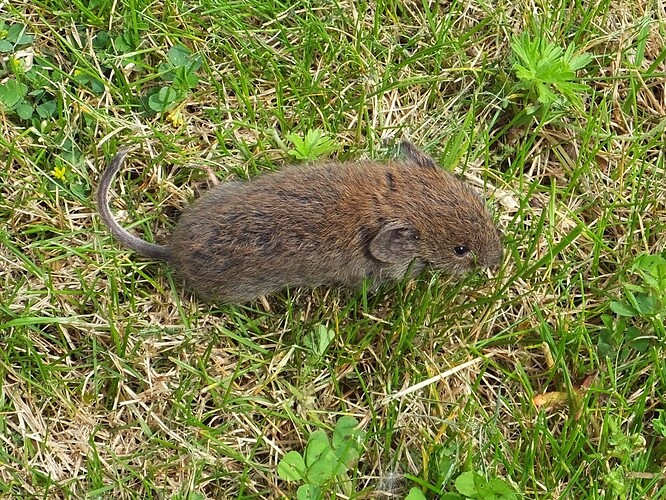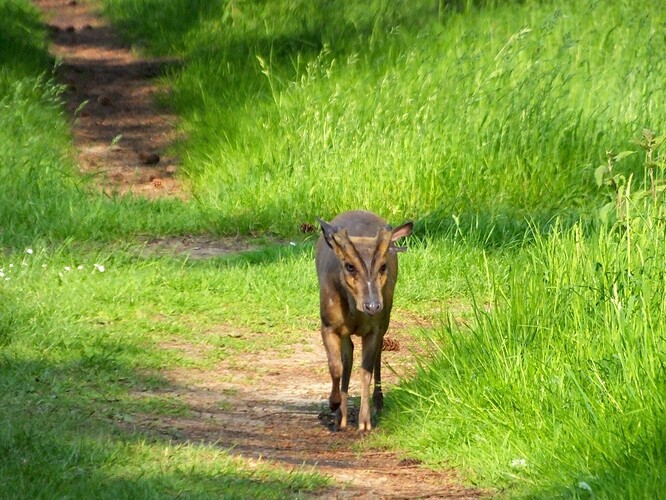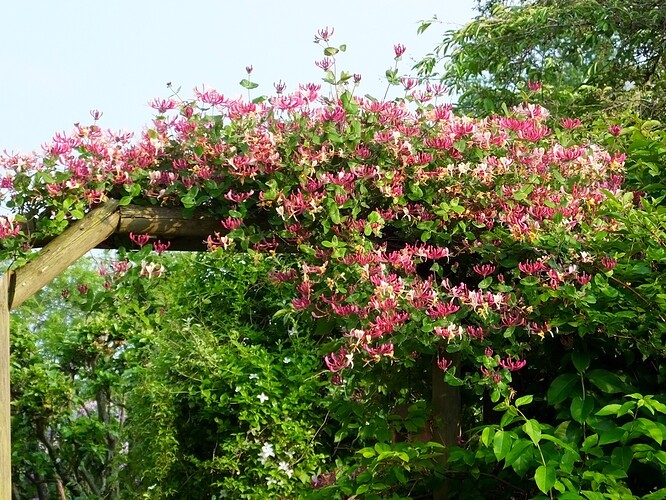Any ideas about how names come to be?
I noticed that bluebell in Cymraeg, clychau’r gog, is cuckoo bells. This makes some sense as they come into flower about the time cuckoos are heard. However, one of my geiriadur aps gave bwtsias y gog and I could not see that they look like boots or that cuckoos could wear boots!! Another geiriadur ap tells me that the boots are actually harebells, not bluebells, and I can see they are more wearable! However, both flowers are definitely more like bells than anything else!
p.s. In parts of Scotland, they call harebells ‘bluebells’ and insist on ‘wild hyacinths’ for bluebells! I think these may be areas with little woodland where harebells are the more common of the two!
I don’t know but would love a Welsh dictionary that had that level of detail.
It seems the bluebell goes by lots of names in Welsh:
To call bluebells ‘wild hyacinths’ would be more accurate botanically.
I know that @raymondkefford but it doesn’t make it any easier to take when my so-called-friend from Dundee corrects me every time I say “bluebell”!!

Llwyd y Gwrych ifanc (hedge sparrow / dunnock) yn fy ngardd y bore.
This prompted me to look up pedantic in welsh - edrych i fyny bedantig yn gymraeg.
I suspect we all have a sample of it lurking somewhere, where’as normally such incidents pass us bye without an ounce of worry.
I have no good explanation for why my ears pick up the often English habit of saying what when they mean which, i’m sure i normally let it pass without comment but would like to understand why my mind highlights it for me.
Of course i have no problem with my welsh being corrected as it’s one way to improve.
Now this is a bird i’m rather fond of though it often seems ignored by many,
I think it has a very pleasing song to my ears, which so far i have not got a good recording of,
which of course leads to my failings over the last 3 weeks to record a nightingale, which i have been near a couple of times for some great singing plus distant traffic (on roads or in the air), then just as a quiet moment arrives the bird moves to a new tree.
Yet: of course i feel very lucky to see what i do and capture so many interesting images, plus i never know what tomorrows surprise will be. (thanks to all contributors for their input).
Could mention that this Friday, nightjar surveys start, it will be late, it will be dark, the locations we are sent to are randomly chosen, so will i be lucky and hear some where i am sent.
Cheers J.P.
Pob lwc i ti JP. Dwi’n croesi fy mysedd.
This is apposite to what I was going to ask you!
It implies that you can find a nightingale near Oxford! I looked up more about blue and hare bells in my big fat Geiriadur Mawr and found ‘harebell’ given as ‘cloch yr eos’!! Since eos = nightingale, I started thinking about the distribution of these. I never met (heard) one on Gower or here in Yr Alban. Google seems to show maps of them declining rapidly, starting with a few in Cymru, now all gone, but a fair number from there running east. The most recent map suggests oh, so few, and possibly none as far west as Oxford!
Have you managed to hear one? Is there any move to try to repopulate what seems to be a red-list bird.
I’m ashamed I hadn’t thought of them for years and was shocked to find they are a red list bird!!
Since we tidied and slightly repositioned our bird table and I upped the mealworm ration, we have seen the dunnock numbers soar. They have taken to sitting on the railings near our steps waiting for their breakfast (or their babies’ breakfast). The poor blackbirds aren’t getting a look in!!
p.s. I’ve been meaning to show:
17/05/16,
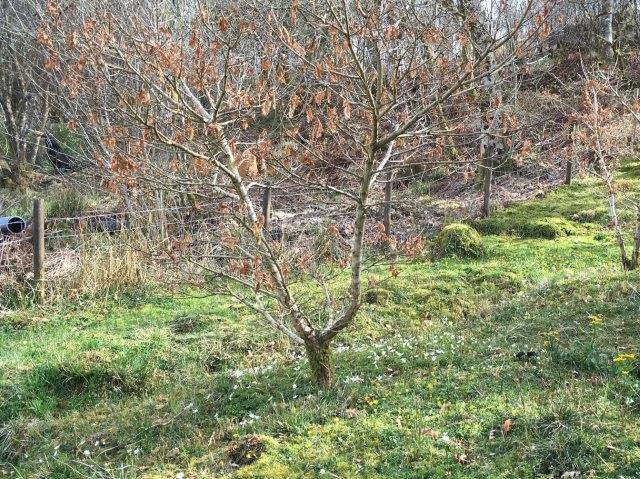
24/05/16 and has been like this for at least 3 days
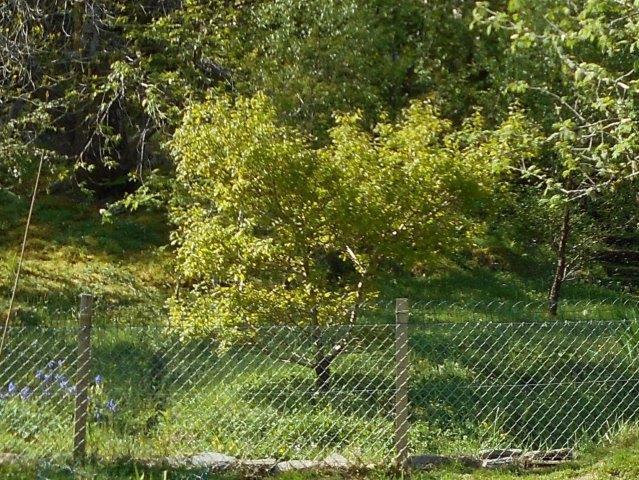
It always makes me think of Prince Andrei in ‘War & Peace’!
Woke to find two Muntjac deer in the garden this morning. I probably have no roses left but can’t bear to look. Ceirw mwntjac.
This little chap was doing much less damage.
Vole - llygoden bengron goch.
The day started early on some old heath land, when i got home i found my misuse of camera controls meant i did not have the film of nightingale - Eos i thought i had , and i had a low quality still image of one.
During the day i had some nice sights.
Gwybedyn Mai - May fly s.p.
Tarianbryf eirin tagu - Sloe bug.
As the light was fading i was out with a group on a nightjar survey (and did we get a good spot).
Yep this one is totally in the dark for the call the male makes.
This is short but possibly interesting, cranck up the volume and listed carefully a couple of times especially for the descending gurgle at the end (the group i was with had not heard this before).
This was the best bit of film i managed in twilight.
Cheers J.P.
For the steam enthusiasts.
Tren ager - steam train.
The flying scotsman this morning, lucky for us these trains tend to stop at Newbury race course (2 miles away) to fill with water, so we get them gaining speed through Newbury at relatively low speed.
Cheers J.P.
I well remember leaning over a railway bridge near where we first lived in York to watch her passing below!! Lovely engine!
Recently, there was a terrible furore up here when she was all set to come on the re-opened Waverly line and it was cancelled at the last minute by some official who hadn’t had the right paperwork!! It was sorted out! I suspect the UK Government were frightened Scotland might actually declare independence if they annoyed the most Anglo-friendly area (the Borders) by stopping the Flying SCOTSMAN coming to Scotland!!!
Mursen las gyffredin gwrywaidd - Male common blue damsel fly.
Picellwr boliog benywaidd - Female broad bodied chaser (a dragonfly).
Cheers J.P.
Good to see you had a great night last night @ramblingjohn. Loved the nightjar audio.
This carw mwntjac is distinguishable from the other ceirw mwntjac around here by his torn ear. The last time I saw him, he had antlers. Today he appeared to have no sense that I was there & came trotting up towards me as I was walking.
The chaffinch flew away from this photo ![]() but it served to remind me that I’m still struggling with those tricksy ‘gw’ words.
but it served to remind me that I’m still struggling with those tricksy ‘gw’ words.
Honeysuckle - gwyddfid
Neck - gwddf
Goose - gŵydd
Moth - gwyfyn
I keep forgetting where you are Pippa, but here we mainly have red deer, some roe and some sika (introduced) and, I think, some fallow. I’m not sure about muntjac. I know they were introduced down south, but it would depend if some landowner up here fancied shooting them whether they moved north!!!
Your honeysuckle is very prettily coloured. Ours is paler. In fact some I had on Gower was just pale cream.
Derwen - Oak.
So far this year i have failed to find any galls on these or other trees.
Gwyfyn y rhos (gwrywaidd) - (male) common heath.
Cheers J.P.
Clearly your oak is a lot bigger than our baban bach, but might I expect galls on the baby? Do you know whether young trees are as likely to be targets?
p.s. to @ramblingjohn It was nice of you to  the above, but you didn’t answer it!!! Sob!
the above, but you didn’t answer it!!! Sob! 
I had very much taken note of your question, and know what i think but was going to ask the opinion of others to augment my answer. (i’ll be back).
Cheers J.P.
I know you’re talking totally different things on here right now but this time of the year isn’t obviusly just time of rain and bad weather (appearantly as it rains quite a lot these days) but it’s also time of births of all kinds. I have two announcements to make (they’re not completely mine of course, but let’s do them anyway).
Our storks have little babies. We can’t see how many of them are there yet as they’re perfectly hidden in a nest but I believe at least 2 are there. When I’ll have the chance I’ll make a picture and post it here.
Then on here’s the miracle happened yesterday in Postojna cave in my own country. You probably know they’ve got about 20 proteus eggs in black aquarium in the cave itself (@margaretnock will know what I’m talking about) and today 1 little baby proteus (human fish we call them and lovingly it’s called little dragon) sprang out of one egg. Not to go into too much details, everything is written here: https://english.sta.si/2269529/baby-dragon-born-in-postojna and a video is here. http://4d.rtvslo.si/arhiv/prispevki-in-izjave-dnevnik/174408853
It’s in Slovene, but you’ll be able to see (umm, well I hope it’s not geo-restricted though) the hatching of the egg and birth of the little “human fish” very well at the beginning of the video.
“pysgod dynol” = “human fish”
storciaid = storks
Hwyl
Tatjana 
